Features of printed shelving
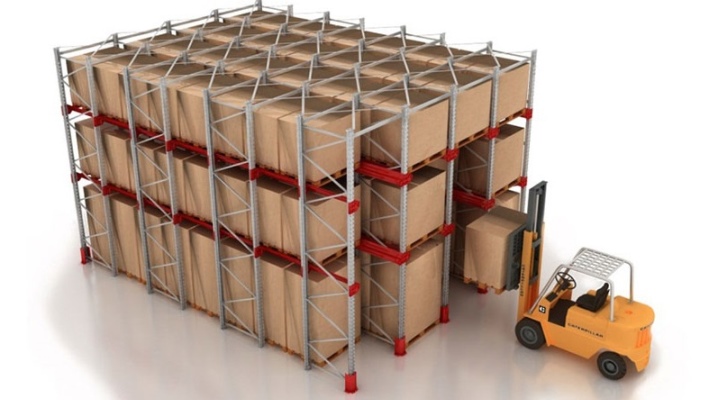
In warehouses where the dislocation of cargo of the same type with a long shelf life is envisaged, it is especially rational to use racked racks. This system makes it possible to maximally densely disperse products on pallets or pallets, and, therefore, use the warehouse space with greater efficiency. The profitability of using warehouse space when installing structures of this type reaches 80%. The capacity, in comparison with ordinary shelving, is 30-40% higher.
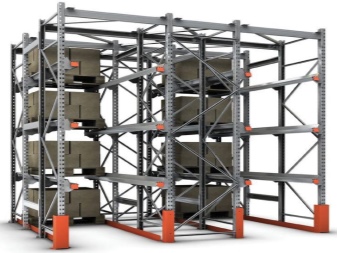

What it is?
Printed racks are a type of warehouse equipment that has become more and more popular lately. This is explained by the fact that this type of device makes it possible to fully utilize the free space of the warehouse, which, as a rule, favors impressive savings.
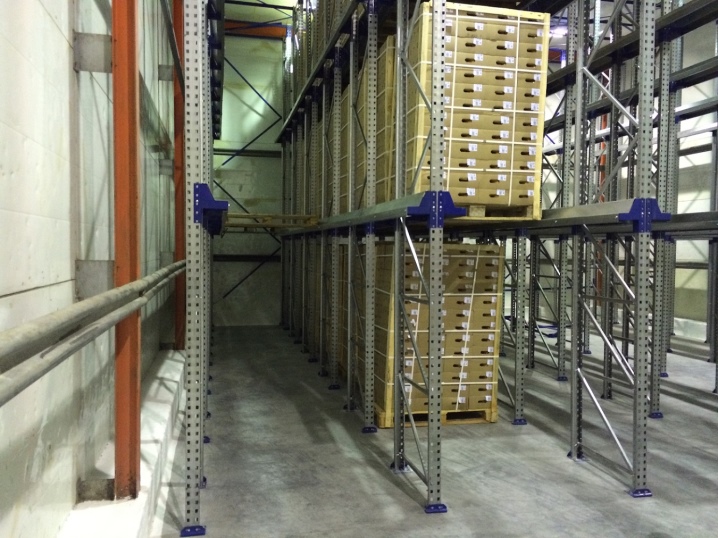
Nevertheless, you cannot simply poke your finger into a sample from the catalog you like and settle down with it. For example, there are different types of racking racks, therefore, it is necessary to make a choice of which particular type will be especially optimal for a particular storage room. And most of the other parameters in the selection of any design must also be taken into account. Therefore, let's sort things out in order.
Mainly, the functions of the shelving structures are displayed in their names. For example, the frontal system is designed to store products from the front, while the gravity system uses gravity to move the load.
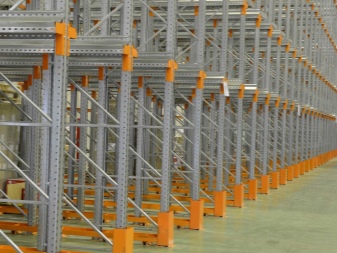

Nevertheless, you can come across such names, from which it is difficult to understand the purpose of the structure (deep, rammed, straight-through). Someone thinks that the above is one and the same. Alas, this misunderstanding is formed due to the lack of a clear system of definitions.
The padded racking is a modification of pallet structures for compact storage. The pallets are placed one after the other in the depth of the rack in one row. This arrangement achieves a compact rack structure.
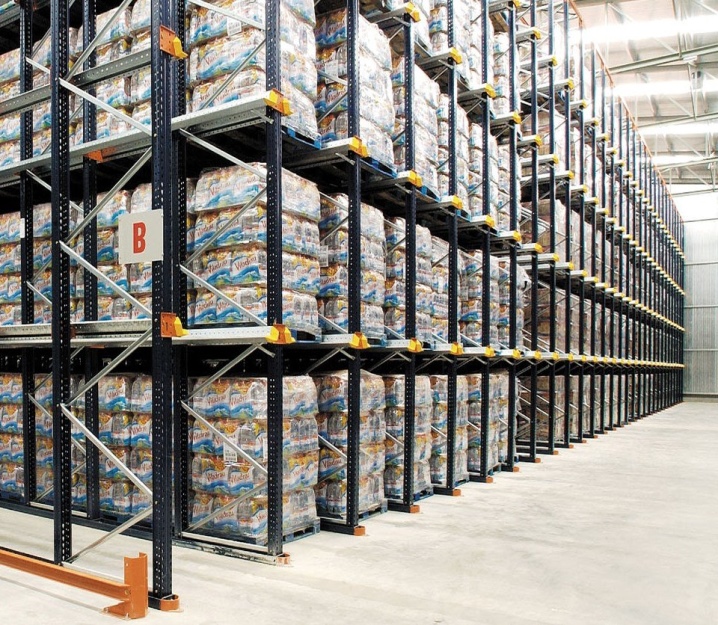
Such structures are a stable frame structure of frames, forming "tunnels" up to 1450 meters wide. Inside, on horizontally oriented guides, pallets with products are placed.
Warehouse area due to such structures is operated with maximum efficiency. By and large, this storage system is an improved way of stacking goods, only with better accessibility, security and control.

Design features. The load-bearing frame of the printed racks includes the following elements:
- vertical frames;
- upper horizontal beams;
- stabilizing screeds;
- Rammed beams are pallet carriers that are fixed to the frame by means of brackets.

In addition to the elements mentioned above, it is advisable to install fences that will protect the end posts and the guide angle for loading equipment. The design is collapsible. It can be easily transformed based on the size of the goods and the principles of the warehouse.
Another name for the drive-in racking... In English, this combination of words means "loading inside" or "stuffing". However, many people mistakenly believe that the word "drive" refers to equipment with movable or gravitational characteristics.As a rule, people who have nothing to do with logistics and warehouses think so. As a result, the English name is mainly used by specialists, and for the rest, the Russian-language version is practiced.

Dignity... As mentioned earlier, this modification of storage racks significantly saves warehouse space (up to 80% of the total storage space is used).
Printed shelving structures realize their capabilities when used for:
- storage of goods of the same type;
- storage of fragile goods where pallets should not be stacked on top of each other.

Among other positive qualities of this type of warehouse equipment:
- simplicity and efficiency of assembly (it is quite easy to dismantle and relocate an empty structure);
- variability in the size of cargo reusable pallets for storage;
- the possibility of stacking in blocks;
- the ability to more efficiently manage large volumes of goods of the same type.
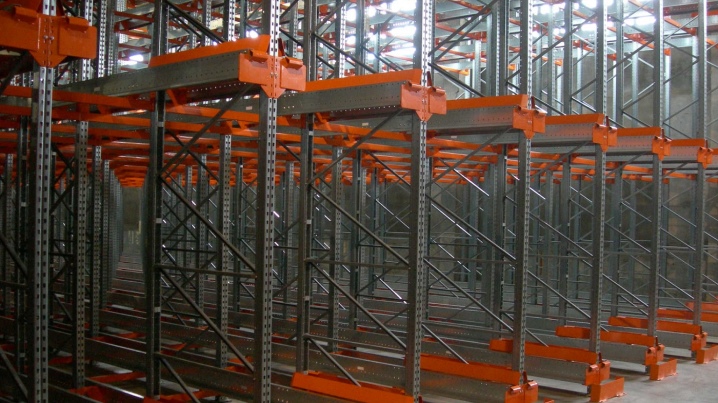
Description of species
By the type of unloading, rammed systems are:
- deep;
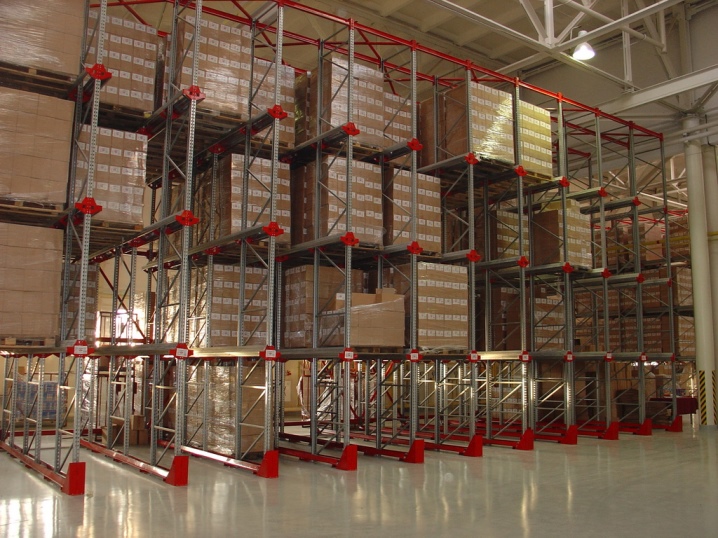
- checkpoints.

Deep modifications. This is the most common type of rammed construction - the stored items are loaded / unloaded from one side of the warehouse (the first pallet sent for storage will be unloaded last).

Such a model is a skeleton of upright racks and horizontal guides. The structure becomes rigid due to high-quality materials used in the manufacture of components, and bolted joints, by means of which the parts are fixed between themselves. The racks have perforations with a small pitch, which makes it possible to choose an acceptable assembly option, taking into account the size of the stored product.
The racks can be disassembled and reassembled if the need arises to redevelop the warehouse. Pallets filled with goods are arranged with the long side inward.

Straight-through padded construction. Its key difference from the above method of organization is the ability to load and unload the stored simultaneously from 2 opposite ends of the storage system. Such processing makes it possible to expand the range of stored products, at the same time, simplifying access to it. The first item shipped for storage from one end of the rack is unloaded first from the opposite end.

This method provides the highest speed of cargo handling in comparison with deep-seated analogs, and loading and unloading operations can be performed at the same time. Walk-through structures are practiced for storing goods of the same type with a limited shelf life. However, it must be taken into account that such a rack uses more usable area, taking into account the need for space for maneuvering loaders from 2 sides.
These racks can be additionally equipped with:
- protective masks of various designs;
- limiters for installing the first pallet in the direction of loading;
- barrier fences (bumpers).
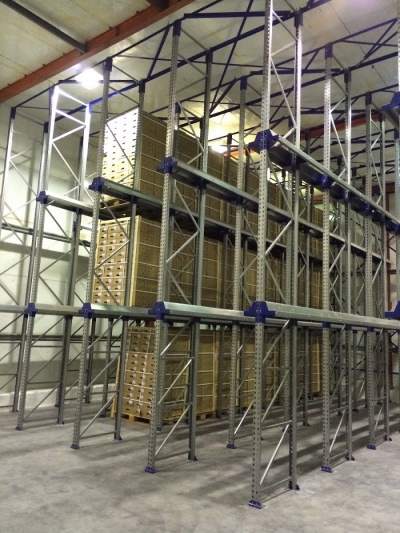
Criterias of choice
Before placing an order for this design for a warehouse, you must carefully learn all of its key characteristics. They are largely similar to the rest of the shelving.
- Type of... You already know that if the loading / unloading of pallets is carried out, on the one hand, then these are rammed deep structures, and if loading / unloading occurs at different ends, then these are rammed pass-through systems that make it possible to increase the speed of logistics, but take away part of the usable area.
- The size... A wide range of rack widths, heights and depths is available from reputable manufacturers, so that you can select them for a specific room and type of pallets used (Euro pallets, Finnish, etc.).In addition, evaluate the perforation spacing of the racks for rearranging the pallet bearing elements - the smaller the spacing, the preferable.
- Load... In order not to pay more for the excessive reinforcement of the structure, one should decide - the cargo with what weight will be stored in the warehouse. Then it is really possible that a structure that can withstand up to 4 tons per level, or up to 40 tons for the entire frame, will be completely unnecessary for you and you should purchase a simpler modification and at a cheaper price.
- Assembly... Although the nut-bolt connection of the racking components is by far the cheapest, it is better to pay extra for modifications with hook fasteners. Since, with the same rigidity and strength of the structure, the assembly of the rack is much easier and faster, including in the process of transforming it for a different type of cargo.
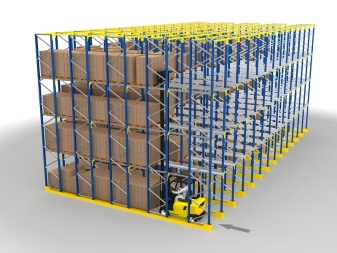

Basic selection criteria.
- Purpose of application... Manufacturers produce several dozen modifications that differ in purpose: medical, exhibition, office, warehouse, and so on.
- Terms of Use... The specifics of the room are also envisaged - with a high level of humidity, you should pay attention to systems with an anti-corrosive coating.
- Carrying capacity ranges from several kilograms to tons, however, the characteristics should be carefully checked - the greatest load is indicated on the tier, shelf, section, and so on.
- The nature of the goods. Based on the characteristics of the stored goods, their sizes, taking into account the container.
- Price... It is not without reason that this item is listed at the very end of the list. Remember that good things cannot be cheap.



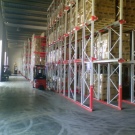


Plus, don't forget to fully evaluate the shelving manufacturer.... How long has he been manufacturing such products for warehouses, is he able to prove its quality by means of a solid brand guarantee and certificates. To what extent is it competitively priced products? With the answers to these questions, you are more likely to determine whether the company and the racks it produces are trustworthy.














The comment was sent successfully.